How to Grow and Care For A Spider Plant
Today, I am going to talk about spider plant care, or by its real name, the chlorophytum.
Today, I’m going to be discussing water, light, fertilizing, propagation, all of that good stuff so that you have a super happy and healthy spider plant without crispy tips.
That is probably the number one question people have about spider plants. How do you get rid of the crispy brown tips? Well, today I’m going to tell you exactly how to do so. I will pop some time codes up, and we can just go ahead and jump right in.
Table of Contents
Spider Plant Characteristics and Varieties
Anyway, so spider plant is a wonderful, wonderful house plant, and honestly, that’s probably why you see it in homes so often. It is an easy grower, a fast grower.
And usually, the cutest part about spider plants is that people typically have really positive native or homely associations with it. So I find the spider plant to be a really exciting and sweet plant because usually, there is very little bad to say about the spider plant.
Besides the typical standard green form. There are many variations, like the Bonnie and stuff like that, which is the really curly spider plant. But just so you know, there are different types of spider plants, and the care doesn’t vary super crazy, especially among the variegated varieties.
But it’s always fun to know what spider plant you have in your home.
Things You Should Know
A general tip for the spider plant, which doesn’t really fit in any of the categories I’m going to be talking about, is that this plant grows out.
So if you do bring a spider plant into your home, even a small one, because remember, they grow really quickly, just make sure that you have enough space for it all around the plant. Otherwise, you will probably experience some pressing against the wall or other plants or a bookshelf, and the leaf might snap.
So if you want a really healthy grown-out plant with no bends and breaks, I definitely recommend giving it a good 360 open space.
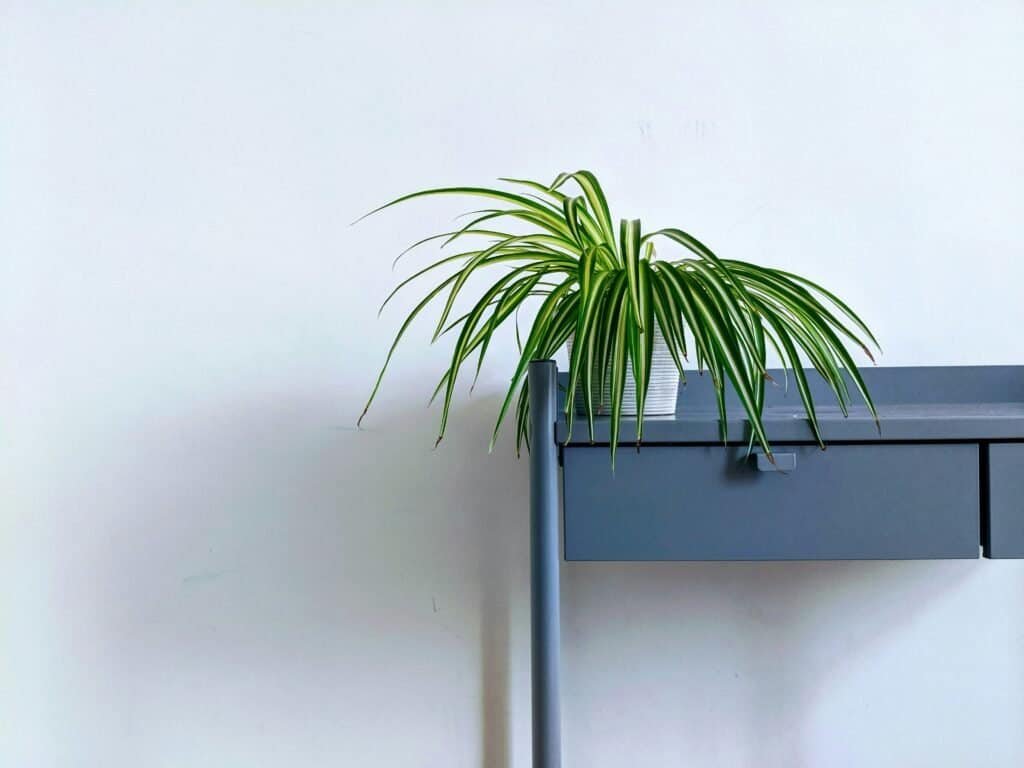
Watering
Now moving on to more specific care, we’re going to start with water. So spider plants do not want to completely dry out.
They do like a little bit of moisture in the soil. I use a moisture meter, honestly, to really tell when to water my plants, and I water when the moisture meter is at about a three.
However, in the winter, I do water even less, so I would probably water around a two, or if I’m feeling crazy, a one. There are some visual cues for when this plant is thirsty, so you might see its leaves are drooping down a little bit, but usually by that point, it is a little bit too late and too dry.
So if you are consistently waiting for it to start drooping, you will probably see crispy tips. So for too little water, you will see some drooping and crispy tips, like I said. But for too much water, you will probably see the leaves starting to get really soft and yellow yellow, and maybe some mushiness by the base.
And if you pull the plant out of the pot, you will see black, mushy stems. And basically, that means that your plant has root rot and was sitting in overwatered soil for too long.
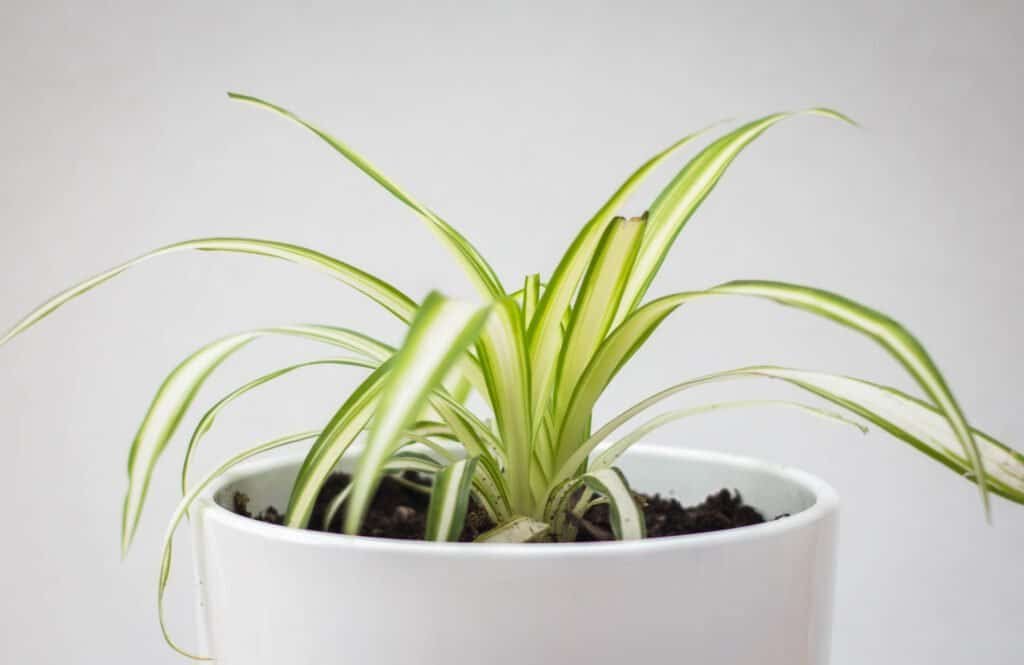
The last little bit about water that is super important for these plants is that they really, really benefit from using distilled or filtered water.
These plants are very, very sensitive to the chemicals often found in tap water. So even if you water them a couple of times with tap water, which I have done, you will see crispy tips.
So I know that my plant got crispy tips from the few times that I have watered it with tap water.
Light
Spider plants really, really love bright indirect light, and they do well in artificial lighting, which is also why it’s a popular office plant.
But for the best results, I definitely recommend bright indirect light, preferably sunlight. When this plant is not getting enough light, the two signs that you will see are, again, drooping leaves, but also a lot of the leaves are going to come in very thin and dainty and a little scraggly-looking.
On the flip side, if your plant is getting too much light, so if it’s too strong and too direct, you’ll see your plant starting to look a little bit chloronic and pale because it’s getting a little bit bleached out by that harsh light. I cannot advocate for proper lighting enough because it truly makes such a difference with these plants.
Oftentimes, spider plants are categorized as low light-tolerant plants, but I clearly beg to differ. I think it makes a huge difference in not only the health of the plant, but how fast it grows. And yeah, just do yourself a favor and give your spider plant good light, especially if it has variation.
The last thing that I will say about light, which It contradicts what I just said a little bit, is apparently too much light can prevent the spider plant from giving you babies, which I wasn’t really sure about because a lot of the YouTube videos I’ve watched specifically tell you to put them under strong light if you want little pups.

But I have been keeping, especially the larger plant, under strong light, and I have not had any babies yet.
I don’t know if I have to be more patient and just give it more time and mature a little bit more. But apparently, days and long nights or periods of darkness will promote babies. So I’m not really sure about that one. I can’t give you a strong, solid answer because what I believe to be true isn’t working for me.
If you have any tips in this area, please let me know because I’m very interested to hear what your experience was.
Soil and Repotting
Soil and repotting is another category that is extremely important for spider plants. Their roots are extremely fleshy and tuberous and very, very strong, so you do not want to put off repotting for too long.
Otherwise, you will find that the roots are attaching themselves to the terracotta if it is potted in terracotta. And you also risk the chance that the roots are actually going to burst open the pot. Some signs to look for that means that your plant needs to be repotted are roots poking out of the top right here.
And lastly, if your plant is declining, so not even just slowed growth, but actually doing bad, and you didn’t change anything else with its care, it also probably means that it needs a new pot. At minimum, you will probably be repotting your plants about once a year, especially if it’s in optimal conditions.
When repotting these plants, use a soil mixture that is fairly airy, So it does have a little bit of perlite or pumace, but also retains enough water that it’s not going straight through and leaving the spider plant to dry. Because as I said, they do like a little bit of moisture.
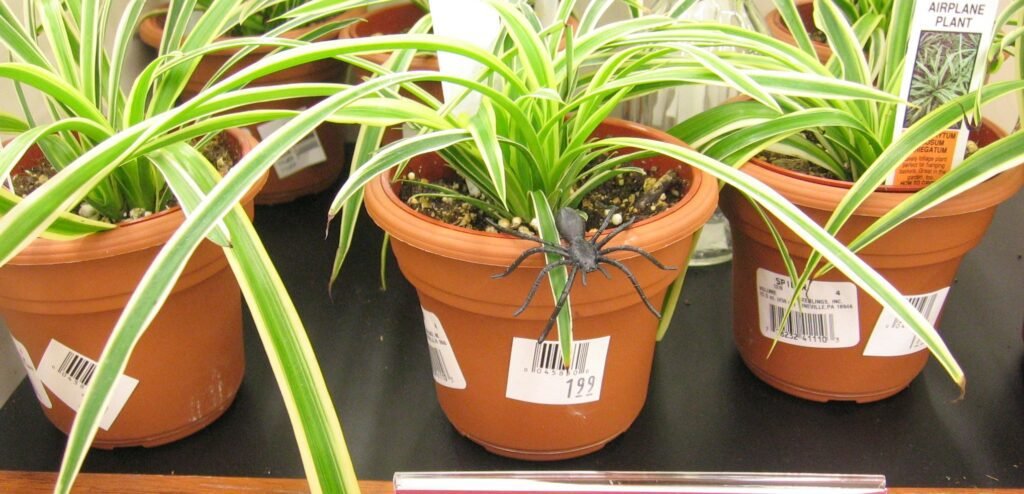
Humidity and Temperature
Okay, humidity and temperature. This plant will do just fine in your average home temperature, which is about, I think, 65 degrees Fahrenheit on the low end, but it can go up to about 90 degrees Fahrenheit in the higher end. But I don’t know. My home is not 90 degrees. Humidity It’s a little bit flexible as well.
It can do well in your home average humidity but higher humidity will definitely help to prevent the crispy tips we talk about before
Fertilizer
This plant naturaly grow. It doesn’t need that much of extra boost. When you do fertilize make sure that you are using a organic fertilizer. I use a organic plant fertilizer.
Propagation
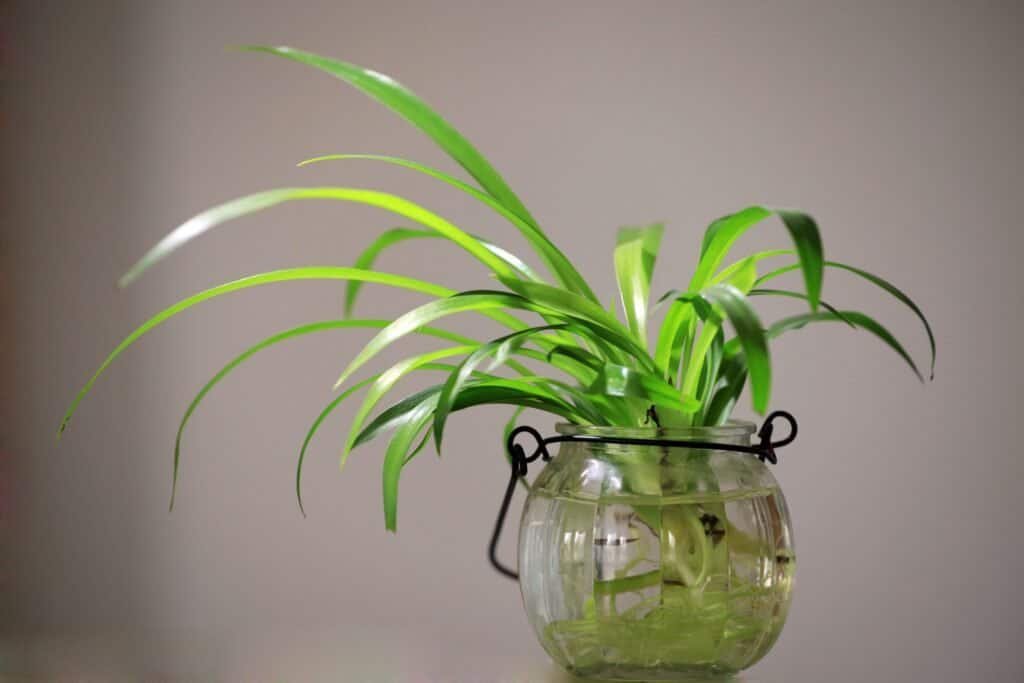
This plants are the queens of propagation. They prop their babies than no other plants. You can put it in water to propagate or some of the varities pros their babies in their leaves.
As it is easy to propagate you can get a penny of spider plant over a year. After planting it in soil I recommend to moisture the soil at lease a week. But I was really not successful in putting plantlets in soil than water.
Though Experience is vary to person to person. Some of my friends had much success in planting the plantlets in soil.
So those are all the tips I have in caring a spider plant. I hope you have learned a little bit about spider plant care, and this article can help you to grow a healthy one!

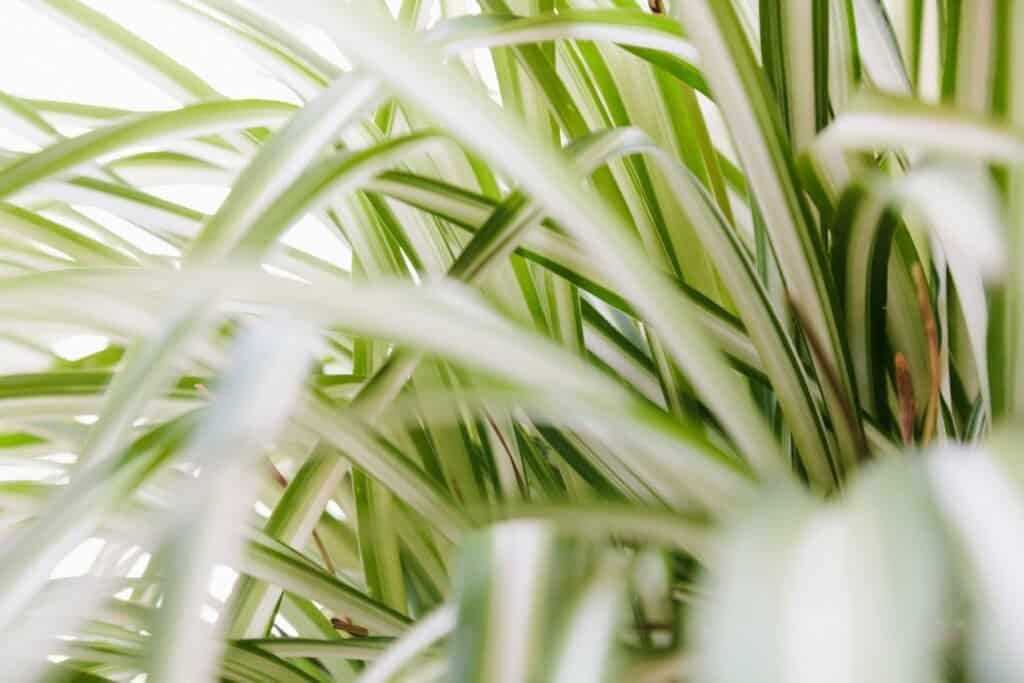





 *(Include an image of droopy leaves)* Some plants, such as calatheas, prefer moist soil at all times; otherwise, they develop that signature brown tissue damage on the leaves. The annoying thing here is that the damage cannot be reversed and can only be cut away, leaving you with a damaged plant. If the soil of your plant is bone dry, you'll notice that it's pulling away from the sides of the pot. This is because the soil has shrunk due to a lack of moisture, so make sure you are not letting this happen by watering a little more frequently. #### Signs Your Plant is Overwatered (darkgreen) Overwatering plants is a really common way that people kill their plants. Beginner plant enthusiasts often have a common misconception that houseplants need lots of water, but the reality is that these plants are native to hot climates where they may get periods of drought followed by large rain which rehydrates them. **Yellowing leaves** (red) can indicate an overwatering problem as well as an underwatering problem. If you are watering your plant too often and the soil is always wet, this can lead to root rot, which will begin to affect the leaves of your plant. **Limp and mushy leaves** (red) also indicate that you are overwatering your plant. This is particularly true with succulents such as Echeverias. Echeverias store water in their thick leaves and have difficulty storing excess water if you are watering your plant too often. This leads to mushy plants that eventually fall off.  *(Include an image of yellowing leaves)* Philodendron and Pothos plants tend to get mushy leaves that fall off if the soil is consistently soggy. My Philodendron Birkin recently developed some new brown leaves that fell off because I was overwatering it. Whereas crispy brown edges on leaves indicate an underwatering problem, if the whole leaves are turning brown, this tends to mean that the plant tissue is rotting due to too much water. You may also notice some water droplets on the ends of the leaves of some of your plants. This is the plant perspiring excess water through its leaves and can indicate that you are giving the plant too much water. Now, this tends to happen on plants that prefer drier soil, and I notice it quite often on my Philodendron Birkin and my Tradescantia Nanook. **Increased presence of fungus gnats** (red) can also be a sign that your plant is too moist. Fungus gnats like a moist top two inches of soil to breed and lay their eggs, so if your soil is wet, it creates a breeding ground for gnats. If you see lots of flea-like flies jumping around the top of your soil, I would just dial back on the watering and let the top two inches of the soil dry out before watering again. #### Watering Tips (darkgreen) It is important to allow the soil of your houseplant to dry out between waterings. This prevents the possibility of over-watering, which is one of the most common reasons people kill their plants. **Check the soil moisture** (red) before watering your plant by sticking your finger two inches into the soil. If it feels wet, leave it a few days and then check again. An even better way to check the soil moisture is to invest in a moisture meter. This device needs no batteries and tells you exactly how much moisture is in the soil, giving you control over watering your plants.  *(Include an image of a moisture meter)* When you identify that your plant needs water, make sure you give it a thorough soaking. Take your plant to a sink area and soak the soil four or five times until water drains out of the bottom each time. This ensures that all the soil in the pot gets moistened and there are no dry patches. **Bottom watering** (teal) is a method that has changed the health of my plants since I implemented it a couple of years ago. Place your plant in a container of water and let it absorb moisture from the bottom up. This method prevents water from getting on the leaves, which can cause leaf tissue damage. I hope this article was helpful. Now you know when to water your plants and when not to. Apply this knowledge to your plants and see the growth. Happy gardening! --- Incorporating these visual and formatting enhancements will make your article more attractive and engaging for your readers.](https://growinggaze.com/wp-content/uploads/2024/05/pexels-artempodrez-7242495-scaled.jpg)

